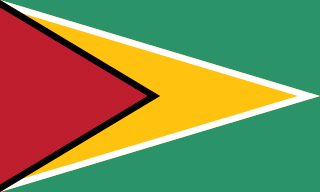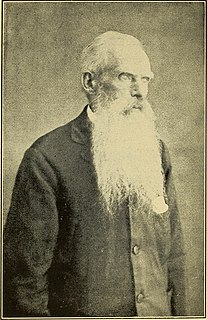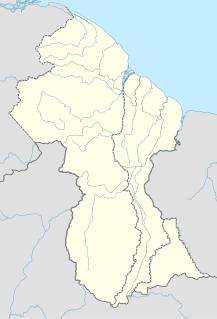
Georgetown is the capital and largest city of Guyana. It is situated in Demerara-Mahaica, region 4, on the Atlantic Ocean coast, at the mouth of the Demerara River. It is nicknamed the "Garden City of the Caribbean." It is the retail and administrative and financial services centre of the country, and the city accounts for a large portion of Guyana's GDP. The city recorded a population of 118,363 in the 2012 census.
The history of Guyana begins about 35,000 years ago with the arrival of humans coming from Eurasia. These migrants became the Carib and Arawak tribes, who met Alonso de Ojeda's first expedition from Spain in 1499 at the Essequibo River. In the ensuing colonial era, Guyana's government was defined by the successive policies of Spanish, French, Dutch, and British settlers.

British Guiana was a British colony, part of the mainland British West Indies, which resides on the northern coast of South America. Since 1966 it has been known as the independent nation of Guyana.

Dutch colonisation of the Guianas—the coastal region between the Orinoco and Amazon rivers in South America—began in the late 16th century. The Dutch originally claimed all of Guiana but—following attempts to sell it first to Bavaria and then to Hanau and the loss of sections to Portugal, Britain, and France—the section actually settled and controlled by the Netherlands became known as Dutch Guiana.

A privately run packet service for mail existed in British Guiana in 1796, and continued for a number of years. Postage stamps of Britain were used in those days at Georgetown (Demerara) and Berbice. The first adhesive stamps produced by British Guiana were issued in 1850.
Sir Everard Ferdinand im Thurn was an author, explorer, botanist, photographer and British colonial administrator. He was Governor of Fiji in the years 1904–1910.

Sir Robert Hermann Schomburgk was a German-born explorer for Great Britain who carried out geographical, ethnological and botanical studies in South America and the West Indies, and also fulfilled diplomatic missions for Great Britain in the Dominican Republic and Thailand.

The Pacaraima or Pakaraima Mountains are a mountain range primarily in southwestern Guyana, and into northern Brazil and eastern Venezuela.

Guayana Esequiba, sometimes also called Esequibo or Essequibo, is a disputed territory of 159,500 km2 (61,600 sq mi) west of the Essequibo River that is administered and controlled by Guyana but claimed by Venezuela. The boundary dispute was inherited from the colonial powers and has been complicated by the independence of Guyana from the United Kingdom in 1966.

Guyana National Museum is a museum in Georgetown, Demerara-Mahaica, Guyana. It was established on 13 February 1868. The idea of starting a museum was conceived by members of the Royal Agricultural and Commercial Society (RACS) of British Guiana. When RACS was established in 1844, one of its aims was to construct a Museum to house local minerals, soils, timbers, fruits, seeds, gums, resins, dyes and drugs, as well as the flora and fauna of the country. British explorer Robert Schomburgk, the German botanist Carl Ferdinand Appun, Mr Bratt, and W.H. Campbell presented gifts to the RACS in order to start a Museum Collection. A fire in 1864 destroyed the donated collections.

Walter Edmund Roth was a British colonial administrator, anthropologist and medical practitioner, who worked in Queensland, Australia and British Guiana between 1898 and 1928.

Guyana, officially the Co‑operative Republic of Guyana, is a country on the northern mainland of South America and the capital city is Georgetown. Guyana is bordered by the Atlantic Ocean to the north, Brazil to the south and southwest, Venezuela to the west, and Suriname to the east. With 215,000 square kilometres (83,000 sq mi), Guyana is the third-smallest sovereign state by area in mainland South America after Uruguay and Suriname; it is also the second-least populous sovereign state in South America after Suriname.

The people of Guyana, or Guyanese, come from a wide array of backgrounds and cultures including aboriginal Amerindians, and those who descended from the slaves brought to work in the sugar industry of the Caribbean by various European interests, mostly of African or Indian origin. Demographics as of 2012 are East Indian 39.8%, African descent 29.3%, mixed 19.9%, Amerindian 10.5%, other 0.5%.

The history of the Jews in Guyana goes as far back at the 1600s. Representation has always been low, and by the 1930s there was neither an organized Jewish community nor a synagogue in the capital city of Georgetown. In the late 19th and early 20th centuries, several Jewish families immigrated to British Guiana from Arab lands to avoid persecution and expand business opportunities.
Audrey Joan Butt Colson, is a social anthropologist with a particular interest in the Amerindian peoples of Guyana, Brazil and Venezuela. She was, together with Peter Rivière, one of the pioneers of Amazonian anthropology at the University of Oxford.

The Manpower Citizens' Association was a trade union and political party in British Guiana.

James Rodway was an eminent British-born Guyanese historian, botanist and novelist. Widely credited as Guyana's premier historian, Rodway helped to establish national institutions such as the Royal Agricultural and Commercial Society of British Guiana and the British Guiana Museum. A fellow of the Linnean Society, in later years he served as Editor of the colony's literary and scientific journal, Timehri.
The Argosy was a newspaper published in Georgetown, Demerara, in British Guiana from 2 October 1880 to 30 March 1907. It became the Weekly Argosy with effect from the issue of 6 April 1907 and ceased publication with the issue of 24 October 1908. It was founded by James Thompson.

Cummingsburg, or historically Cumingsburg, is a ward in Georgetown, Guyana. It began as 500-acre plantation, La Bourgade about 1759. When Thomas Cumming, a Scotsman, bought the property, he developed a town plan with residential and commercial lots and streets. The town layout was modified after a fire that burnt much of the town in 1864. Today, it is the site of several museums, including a national and anthropological museum.














